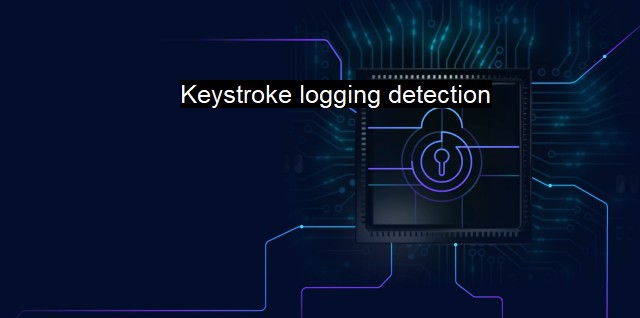What is Keystroke logging detection?
The Increasing Threat of Keystroke Logging: Examining the Tactics of Cybercriminals onsystem Vulnerabilities to Bypass Antivirus Protection
Keystroke logging, also referred to as keylogging, is a sinister method employed by cybercriminals to track and log keys struck on a keyboard, typically without the user's knowledge or consent. This invasive technique enables hackers to capture confidential information such as usernames, passwords, credit card details and other sensitive data. As a chilling aspect of cybersecurity threats, the use of keyloggers poses severe risks to both personal privacy as well as business confidentiality. fear not, as a countermeasure to this security concern, technology has developed techniques known as 'Keystroke logging detection', which are pivotal components in the antivirus programs and security processes used today.Keystroke logging detection primarily functions by identifying the presence of keyloggers on a system. This safeguard is pivotal as even technologically savvy users can fall prey to keylogger infections due to the subtlety of keystroke logger's invasive measures. Various tools, techniques and software exist to expedite defenses against keyloggers in both preemptive and reactive ways.
Antivirus software provides a first line of defense against keyloggers by continuously scanning the computer for any suspicious activity, including the recognized signatures of known keyloggers. The mitigation capacity of a specific antivirus software towards keyloggers usually unwinds on its accuracy in recognizing virus signatures amalgamated within database files. it checks for anomaly-based patterns that suggest unauthorized keystroke actions in the user's device.
Some keyloggers can evade this method by disguising their actions or modifying their signatures. Therefore, in addition to signature-based detection, some antivirus programs embrace behavior-based detection algorithms. These systems closely monitor the behavior of application and system processes, alerting the user to any actions suggestive of keylogging attempts. Such detection works by probing actions such as keystrokes, data sending over the internet, files and memory access, etc.
Yet another layer of protection against keyloggers comes from the use of encryption. Encryption tools scramble sensitive information transmitted from the user's keyboard to the computer applications and browser. Through utilizing a secure independent pathway or encrypted keystrokes, even if a keylogger manages to infiltrate, it will only mirror encrypted data, rendering the collected information unreadable and consequently useless.
More advanced tools for keystroke logging detection employ the use of sandboxing and virtual keyboards. Sandboxing works by providing a tightly controlled set of resources for guest programs to run, thereby isolating the effect of running the keyloggers and making them harmless. Virtual keyboards, on the other hand, let users input their sensitive information without any physical keystrokes. These buttons don't involve keystrokes and thus cannot be logged by keyloggers.
While these detection methods significantly dampen the potential damage caused by keyloggers, user discretion still has an important role to play. Users should steer clear from opening suspicious emails, visiting unsettling websites or downloading obscure software. Regular system updates, secure browsing, installation of security patches and being cautious about unplugging unfamiliar devices can significantly fortify a system's resilience against threats of keyloggers.
Network security mechanisms such as Intrusion Detection Systems (IDS) and Intrusion Prevention Systems (IPS) may leverage data mining techniques to detect any deviations from normal activities signaling an attack. They may look at variabilities in timing/swiftly maltyped-correction pairs regarding the pulse–pause ratio, which might be characteristic of a specific keylogger’s common signature or behavior.
Investing in robust security solutions while embracing best digital practices can serve as a robust shield against harmful keyloggers. Contemporary threats continue to evolve, alongside advancements in detection and defense mechanisms. In the perennial security cat-and-mouse game, constant vigilance and proactive defenses remain paramount to stay protected against cyber threats. Keystroke logging detection is not a standalone solution, but as part of an integrated security strategy, it forms an indispensable dimension of total cybersecurity.

Keystroke logging detection FAQs
What is keystroke logging detection?
Keystroke logging detection is a technology used in cybersecurity to identify and prevent keystroke logging activity. It alerts the user or antivirus software when an unauthorized party is monitoring and logging their keyboard activity.How does keystroke logging detection work?
Keystroke logging detection works by analyzing the behavior of keyboard activity. It identifies any unusual activity or keyboard shortcuts that a user may not have executed. The technology then alerts the user or antivirus software and blocks the logging activity.What are some common methods used for keystroke logging detection?
Some common methods used for keystroke logging detection include analyzing network traffic, monitoring system processes, and scanning for signatures of known keystroke logging malware. Additionally, some antivirus software comes equipped with keystroke logging detection features.Why is keystroke logging detection important for cybersecurity?
Keystroke logging is a common method used by hackers to steal sensitive information such as passwords, credit card numbers, and personal data. It is important to have keystroke logging detection in place to prevent these attacks and safeguard sensitive information from falling into the wrong hands.| | A | | | B | | | C | | | D | | | E | | | F | | | G | | | H | | | I | | | J | | | K | | | L | | | M | |
| | N | | | O | | | P | | | Q | | | R | | | S | | | T | | | U | | | V | | | W | | | X | | | Y | | | Z | |
| | 1 | | | 2 | | | 3 | | | 4 | | | 7 | | | 8 | | |||||||